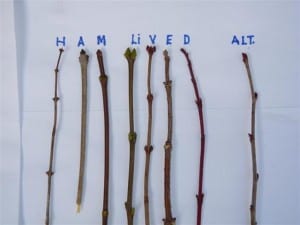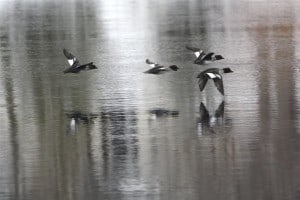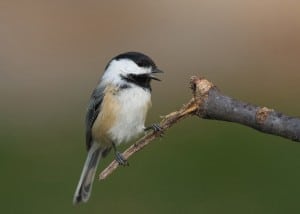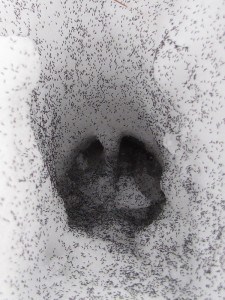“If we had no winter, the spring would not be so pleasant.”
– Anne Bradstreet
Despite the bone-chilling cold of this winter’s Polar Vortex, life carries on all around us. It might just take a little more effort to seek it out. To the curious and attentive observer, however, there is wonder in the countless strategies that evolution has bestowed upon plants and animals to survive this, the most unforgiving of seasons.
The events listed below are typical of late January through February in the Kawarthas. However, many of these happenings occur over the entire winter.
Late January
— In late January, this sun rises at about 7:30 am, which is already 15 minutes earlier than a month ago. The real daylight gain, however, is in the afternoon. Sunset is not until 5:30 pm, a full 45 minutes later than at New Year’s. This gift of light makes a winter outing all the more enjoyable.
— Watch for small numbers of Common Goldeneyes and Common Mergansers on the Otonabee River and on open sections of both Little Lake (behind the Holiday Inn) and Lake Katchewanooka (Young’s Point).
– Venus puts on a beautiful show in the pre-dawn eastern sky all winter.
— Large numbers of American Robins are overwintering in the Kawarthas this year, thanks mostly to abundant wild food such as Wild Grape. As long as they have enough to eat, the cold is not a problem.
— If you’re driving through open farm country, keep an eye open for huge, swirling flocks of Snow Buntings. It is not uncommon to see hundreds of these mostly white birds in a single flock. The area between Peterborough and Keene can be especially productive. Enter bit.ly/KyGYNM in your browser to see a short video of this bird.
– Coyotes are quite vocal during their January to March mating season and can often be heard on the outskirts of Peterborough. The young are born 60-63 days later, usually in a ground den.

Opposite buds (H=honeysuckle, A=ash, M=maple, LI=lilac, V=viburnum, E=elderberry, D=dogwood) The letters form the mnemonic “HAM LIVED”. The twig on the far right is an example of an alternate-budding species – probably basswood
– The numbers of some winter birds fluctuate widely from year to year. These species are referred to as winter “irruptives,” and the years in which they are particularly common are called “flight years.” Last winter was an excellent flight year for Bohemian Waxwings and Common Redpolls. The only winter irruptive present this year is the Snowy Owl. The owl in the field north of Line 3, just west of Chemong Road was still present as of January 20.
– Because their characteristics are different for each species, quick and accurate tree identification can be made on the basis of the twigs and buds alone. A few species have buds that are arranged opposite each other (e.g., ash, maple) on the twigs, but the majority of trees have buds that are staggered alternately. Making a winter twig collection can be a fun activity.
— In January, Black Bears give birth to cubs no larger than chipmunks. Generally, two cubs are born, although there are sometimes as many as four or five. The amount of food available in the fall is critical in determining the number of young in the litter. Food was abundant this past fall.
February
– The evening of February 1st presents a great opportunity for seeing Mercury, often called the most elusive planet. Mercury will appear directly below tonight’s thin waxing crescent moon.
– Groundhog Day, February 2, marks the mid-point of winter. However, our groundhogs won’t see their shadow – or light of day, for that matter – until mid-March at the earliest. Groundhogs are still comfortably curled up in a ball inside their winter burrow in a state of deep hibernation. Compared to summer, their heartbeat has dropped from 100 beats per minute to only 15, and their body temperature has plummeted from 35 C to only 6 C!
– Although rather tentative at first, bird song returns to the Kawarthas by mid-February as pair bonds are established or renewed. Black-capped Chickadees and Northern Cardinals are among the first songsters off the mark. It is somehow fitting that you will often hear their love songs for the first time at around Valentine’s Day. The chickadee’s three-note whistle is even remembered best as a Valentine’s-appropriate “Hi Sweetie.”
– Gray Squirrels mate in mid-winter and can often be seen streaming by in treetop chases as a group of males chases a frantic female. Some amazing acrobatics are usually part of the show.
– Being very social animals, flying squirrels sometimes join up in single-sex groups for warmth during the winter. They will often choose a tree cavity.
– After the moon, Jupiter is the brightest object in the night sky this month. Look east at nightfall on February 11 and you will see this huge planet shining like a beacon above the Moon. To the left of Jupiter, look for the stars Castor and Pollux in the Gemini constellation. The winter moon rides higher in the sky than at any other season and passes nearly overhead at midnight.
– One millimetre-long snow fleas can often be seen on the snow along the edge of woodland paths or cross-country ski trails on mild February days. What at first glance may seem like a sprinkling of pepper is actually a bunch of tiny invertebrates looking for microscopic morsels of food. Snow fleas, also known as springtails, have two appendages held in place by hooks. When the hooks are released, a springing action results which sends the insect catapulting through the air. If a snow flea was as big as a human, it could jump as high as a 20-storey apartment building.
– The Virginia Opossum, a marsupial that is native to the southeastern U.S., is extending its range northward into the Kawarthas as our winters become milder. These mostly nocturnal animals are sometimes attracted to bird feeders where they will eat spilled seed. Two were seen recently at a house on Johnston Drive near the Peterborough Airport.
– The 17th Great Backyard Bird Count (GBBC) takes place February 14– 17. All you need to do is count birds for at least 15 minutes on one or more days of the count and enter your sightings on-line. A wonderful example of “citizen science”, the GBBC engages tens of thousands of bird watchers of all levels of expertise in order to create a real-time snapshot of the whereabouts and relative abundance of bird populations in mid-winter. Please try to take part, even if your backyard feeder is not that active. Information on what birds are absent is vitally important. Go to www.birdcount.org for details.
– On February 25, the planet Venus and the beautiful waning crescent Moon grace the pre-dawn sky. Look to the southeast.
– As March approaches, winter is definitely on the ebb. The sun is rising and setting further and further north and tracing a higher arc through the sky which makes for longer days. Daylight is with us until almost 6:30.
– Can’t wait for the greenery and blossoms of spring? Try cutting some 8-12 inch twigs (e.g., forsythia, willow, dogwood, cherry, apple) for forcing indoors. Just put them in a vase of water and set them in a sunny window. Within a few days, you should see flowers and/or leaves emerging.


